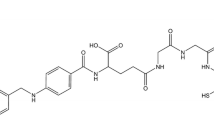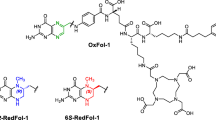Abstract
Purpose
The radiolanthanide 161Tb (T 1/2 = 6.90 days, Eβ− av = 154 keV) was recently proposed as a potential alternative to 177Lu (T 1/2 = 6.71 days, Eβ− av = 134 keV) due to similar physical decay characteristics but additional conversion and Auger electrons that may enhance the therapeutic efficacy. The goal of this study was to compare 161Tb and 177Lu in vitro and in vivo using a tumour-targeted DOTA-folate conjugate (cm09).
Methods
161Tb-cm09 and 177Lu-cm09 were tested in vitro on folate receptor (FR)-positive KB and IGROV-1 cancer cells using a 3-(4,5-dimethylthiazol-2-yl)-2,5-diphenyltetrazolium bromide (MTT) viability assay. In vivo 161Tb-cm09 and 177Lu-cm09 (10 MBq, 0.5 nmol) were investigated in two different tumour mouse models with regard to the biodistribution, the possibility for single photon emission computed tomography (SPECT) imaging and the antitumour efficacy. Potentially undesired side effects were monitored over 6 months by determination of plasma parameters and examination of kidney function with quantitative SPECT using 99mTc-dimercaptosuccinic acid (DMSA).
Results
To obtain half-maximal inhibition of tumour cell viability a 4.5-fold (KB) and 1.7-fold (IGROV-1) lower radioactivity concentration was required for 161Tb-cm09 (IC50 ~0.014 MBq/ml and ~2.53 MBq/ml) compared to 177Lu-cm09 (IC50 ~0.063 MBq/ml and ~4.52 MBq/ml). SPECT imaging visualized tumours of mice with both radioconjugates. However, in therapy studies 161Tb-cm09 reduced tumour growth more efficiently than 177Lu-cm09. These findings were in line with the higher absorbed tumour dose for 161Tb-cm09 (3.3 Gy/MBq) compared to 177Lu-cm09 (2.4 Gy/MBq). None of the monitored parameters indicated signs of impaired kidney function over the whole time period of investigation after injection of the radiofolates.
Conclusion
Compared to 177Lu-cm09 we demonstrated equal imaging features for 161Tb-cm09 but an increased therapeutic efficacy for 161Tb-cm09 in both tumour cell lines in vitro and in vivo. Further preclinical studies using other tumour-targeting radioconjugates are clearly necessary to draw final conclusions about the future clinical perspectives of 161Tb.






Similar content being viewed by others
References
Teunissen JJ, Kwekkeboom DJ, Valkema R, Krenning EP. Nuclear medicine techniques for the imaging and treatment of neuroendocrine tumours. Endocr Relat Cancer 2011;18 Suppl 1:S27–51.
Teunissen JJ, Kwekkeboom DJ, Krenning EP. Quality of life in patients with gastroenteropancreatic tumors treated with [177Lu-DOTA0, Tyr3]octreotate. J Clin Oncol 2004;22:2724–9.
Otte A, Herrmann R, Heppeler A, Behe M, Jermann E, Powell P, et al. Yttrium-90 DOTATOC: first clinical results. Eur J Nucl Med 1999;26:1439–47.
Cybulla M, Weiner SM, Otte A. End-stage renal disease after treatment with 90Y-DOTATOC. Eur J Nucl Med 2001;28:1552–4.
Rolleman EJ, Melis M, Valkema R, Boerman OC, Krenning EP, de Jong M. Kidney protection during peptide receptor radionuclide therapy with somatostatin analogues. Eur J Nucl Med Mol Imaging 2010;37:1018–31.
Kwekkeboom DJ, Bakker WH, Kam BL, Teunissen JJ, Kooij PP, de Herder WW, et al. Treatment of patients with gastro-entero-pancreatic (GEP) tumours with the novel radiolabelled somatostatin analogue [177Lu-DOTA0,Tyr3]octreotate. Eur J Nucl Med Mol Imaging 2003;30:417–22.
Kwekkeboom DJ, de Herder WW, Kam BL, van Eijck CH, van Essen M, Kooij PP, et al. Treatment with the radiolabeled somatostatin analog [177Lu-DOTA0,Tyr3]octreotate: toxicity, efficacy, and survival. J Clin Oncol 2008;26:2124–30.
Valkema R, Pauwels SA, Kvols LK, Kwekkeboom DJ, Jamar F, de Jong M, et al. Long-term follow-up of renal function after peptide receptor radiation therapy with 90Y-DOTA0,Tyr3-octreotide and 177Lu-DOTA0,Tyr3-octreotate. J Nucl Med 2005;46 Suppl 1:83S–91S.
Lehenberger S, Barkhausen C, Cohrs S, Fischer E, Grünberg J, John A, et al. The low-energy β− and electron emitter 161Tb as an alternative to 177Lu for targeted radionuclide therapy. Nucl Med Biol 2011;38:917–24.
de Jong M, Breeman WA, Bernard BF, Rolleman EJ, Hofland LJ, Visser TJ, et al. Evaluation in vitro and in rats of 161Tb-DTPA-octreotide, a somatostatin analogue with potential for intraoperative scanning and radiotherapy. Eur J Nucl Med 1995;22:608–16.
Müller C, Zhernosekov K, Köster U, Johnston K, Dorrer H, Hohn A, et al. A unique matched quadruplet of terbium radioisotopes for PET and SPECT and for α- and β-radionuclide therapy: an in vivo proof-of-concept study with a new receptor-targeted folate derivative. J Nucl Med 2012;53:1951–9.
Eckerman K, Endo A. ICRP Publication 107. Nuclear decay data for dosimetric calculations. Ann ICRP 2008;38:7–96.
Müller C, Struthers H, Winiger C, Zhernosekov K, Schibli R. DOTA conjugate with an albumin-binding entity enables the first folic acid-targeted 177Lu-radionuclide tumor therapy in mice. J Nucl Med 2013;54:124–31.
Mosmann T. Rapid colorimetric assay for cellular growth and survival: application to proliferation and cytotoxicity assays. J Immunol Methods 1983;65:55–63.
Mathias CJ, Wang S, Lee RJ, Waters DJ, Low PS, Green MA. Tumor-selective radiopharmaceutical targeting via receptor-mediated endocytosis of gallium-67-deferoxamine-folate. J Nucl Med 1996;37:1003–8.
Reddy JA, Westrick E, Santhapuram HK, Howard SJ, Miller ML, Vetzel M, et al. Folate receptor-specific antitumor activity of EC131, a folate-maytansinoid conjugate. Cancer Res 2007;67:6376–82.
Sanceau J, Poupon MF, Delattre O, Sastre-Garau X, Wietzerbin J. Strong inhibition of Ewing tumor xenograft growth by combination of human interferon-alpha or interferon-beta with ifosfamide. Oncogene 2002;21:7700–9.
Bernhardt P, Benjegård SA, Kölby L, Johanson V, Nilsson O, Ahlman H, et al. Dosimetric comparison of radionuclides for therapy of somatostatin receptor-expressing tumors. Int J Radiat Oncol Biol Phys 2001;51:514–24.
Capello A, Krenning EP, Breeman WA, Bernard BF, de Jong M. Peptide receptor radionuclide therapy in vitro using [111In-DTPA0]octreotide. J Nucl Med 2003;44:98–104.
Ginj M, Hinni K, Tschumi S, Schulz S, Maecke HR. Trifunctional somatostatin-based derivatives designed for targeted radiotherapy using auger electron emitters. J Nucl Med 2005;46:2097–103.
Uusijärvi H, Bernhardt P, Ericsson T, Forssell-Aronsson E. Dosimetric characterization of radionuclides for systemic tumor therapy: influence of particle range, photon emission, and subcellular distribution. Med Phys 2006;33:3260–9.
Forrer F, Valkema R, Bernard B, Schramm NU, Hoppin JW, Rolleman E, et al. In vivo radionuclide uptake quantification using a multi-pinhole SPECT system to predict renal function in small animals. Eur J Nucl Med Mol Imaging 2006;33:1214–7.
Pillai MR, Chakraborty S, Das T, Venkatesh M, Ramamoorthy N. Production logistics of 177Lu for radionuclide therapy. Appl Radiat Isot 2003;59:109–18.
Zhernosekov KP, Perego RC, Dvorakova Z, Henkelmann R, Türler A. Target burn-up corrected specific activity of 177Lu produced via 176Lu(n, γ)177Lu nuclear reactions. Appl Radiat Isot 2008;66:1218–20.
Lebedev NA, Novgorodov AF, Misiak R, Brockmann J, Rösch F. Radiochemical separation of no-carrier-added 177Lu as produced via the 176Yb(n,γ)177Yb–>177Lu process. Appl Radiat Isotopes 2000;53:421–5.
Acknowledgments
We thank Ulli Köster (Institut Langevin, Grenoble, France) for the target irradiation at ILL and Nadja Romano for technical assistance of the experiments at PSI. This project was financially supported by the Swiss National Science Foundation (Ambizione, Grants PZ00P3_121772 & PZ00P3_138834), COST-BM0607 (C08.0026), the Swiss Cancer League (KLS-02762-02-2011) and the Swiss South African Joint Research Program (JRP 12). Peter Bernhardt was supported by the Swedish National Cancer Society, Swedish Radiation Safety Authority, and the King Gustav V Jubilee Cancer Research Foundation.
Conflicts of interest
None.
Author information
Authors and Affiliations
Corresponding authors
Electronic supplementary material
Below is the link to the electronic supplementary material.
ESM 1
(DOC 1.15 MB)
Rights and permissions
About this article
Cite this article
Müller, C., Reber, J., Haller, S. et al. Direct in vitro and in vivo comparison of 161Tb and 177Lu using a tumour-targeting folate conjugate. Eur J Nucl Med Mol Imaging 41, 476–485 (2014). https://doi.org/10.1007/s00259-013-2563-z
Received:
Accepted:
Published:
Issue Date:
DOI: https://doi.org/10.1007/s00259-013-2563-z




